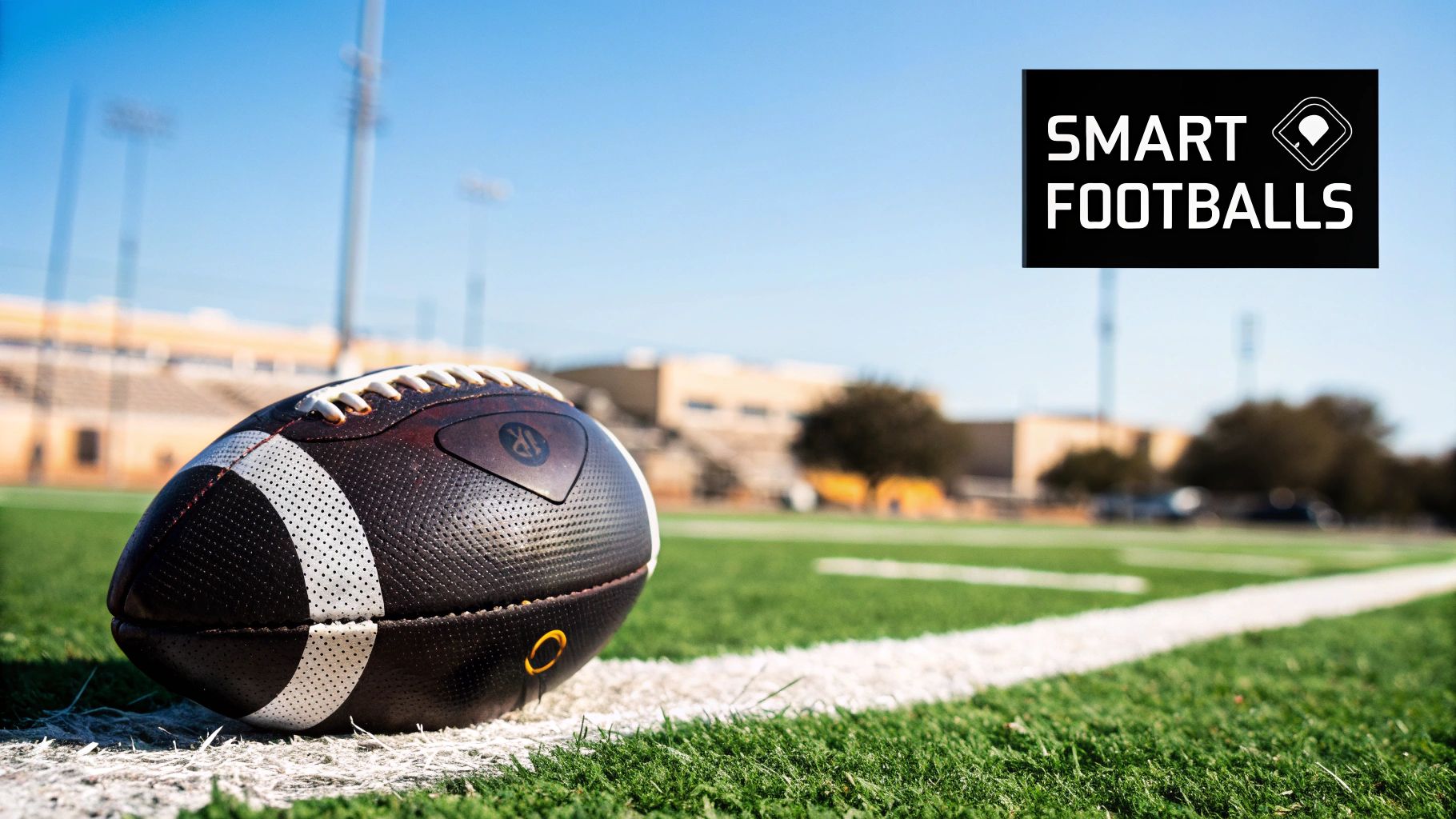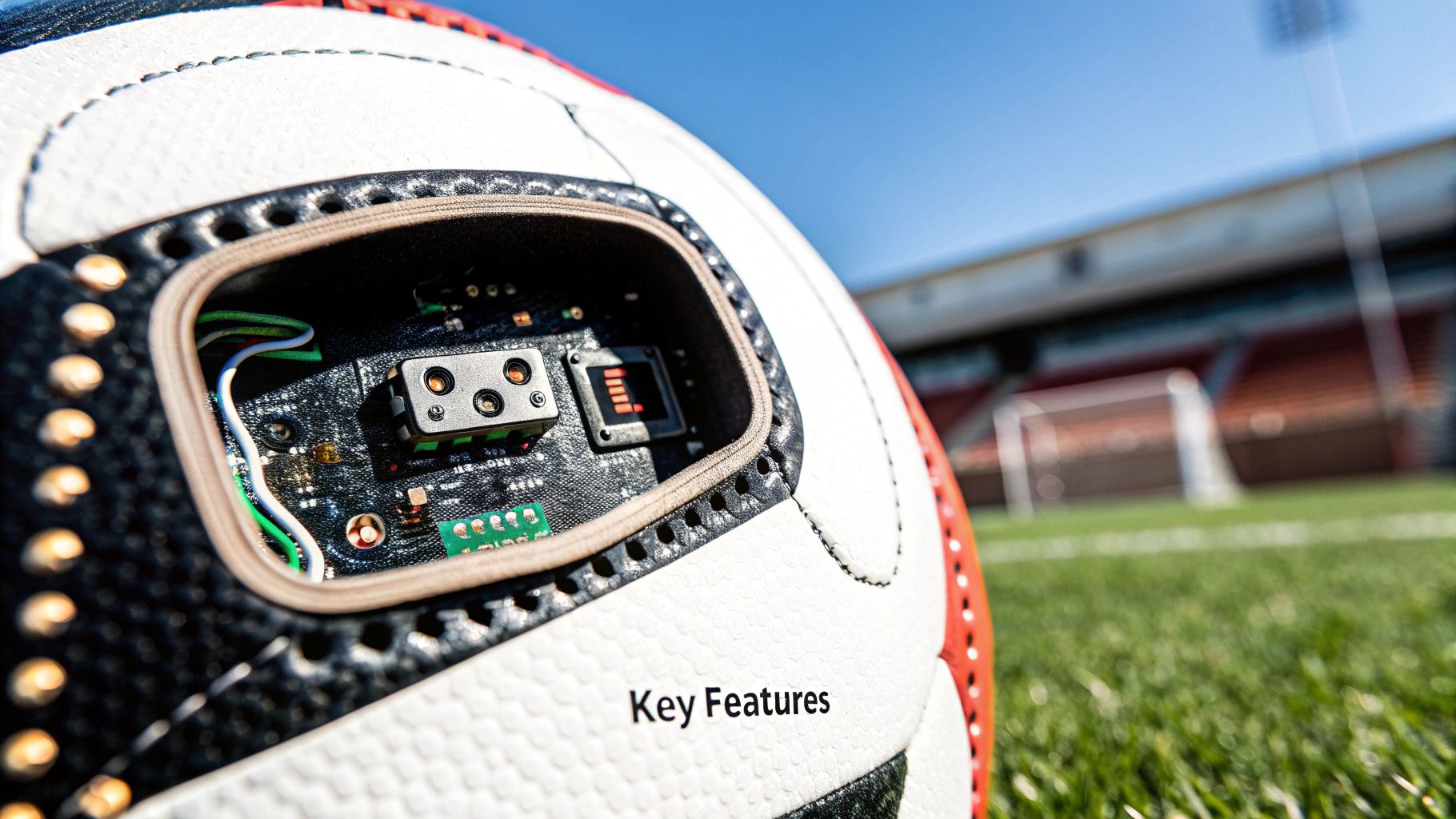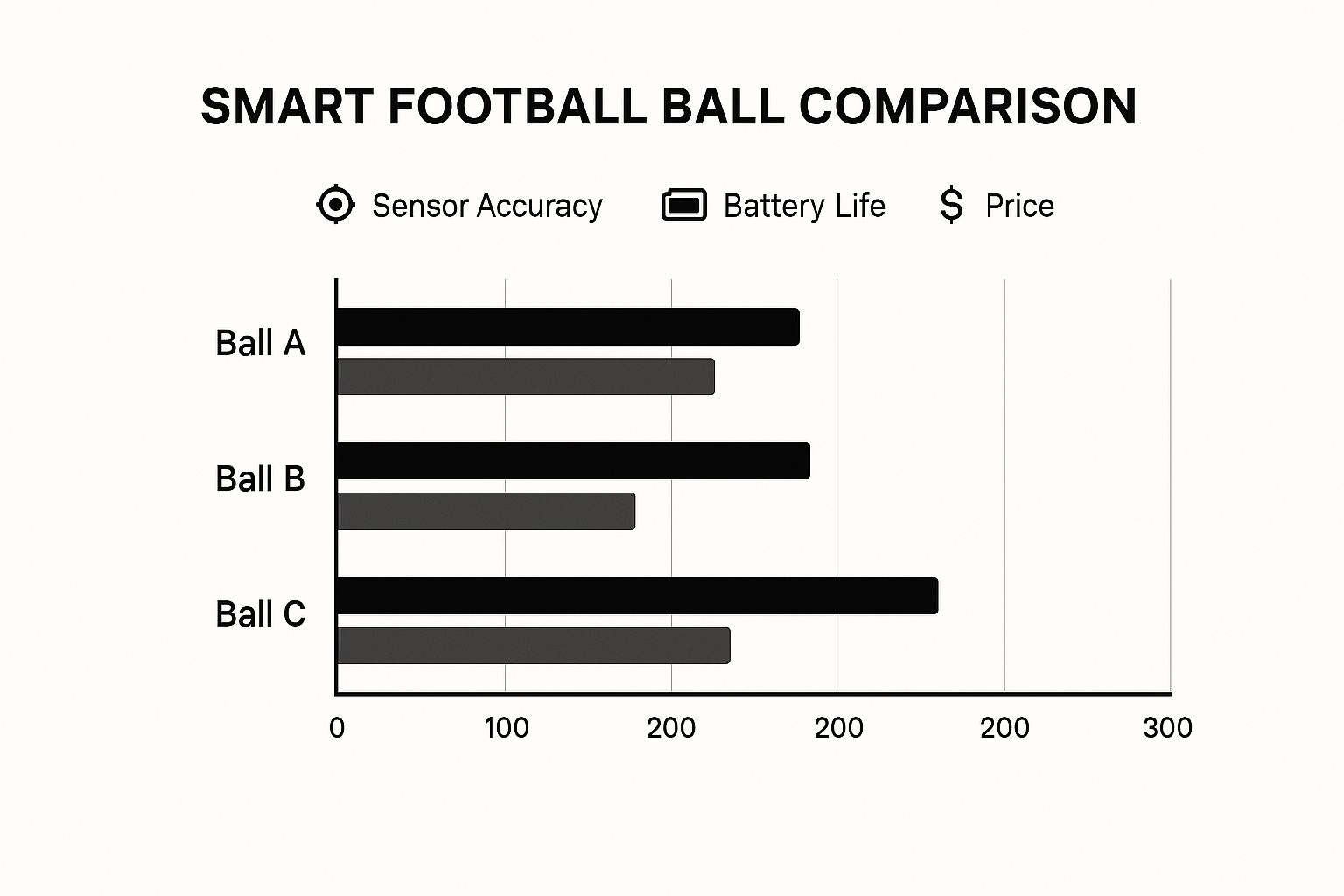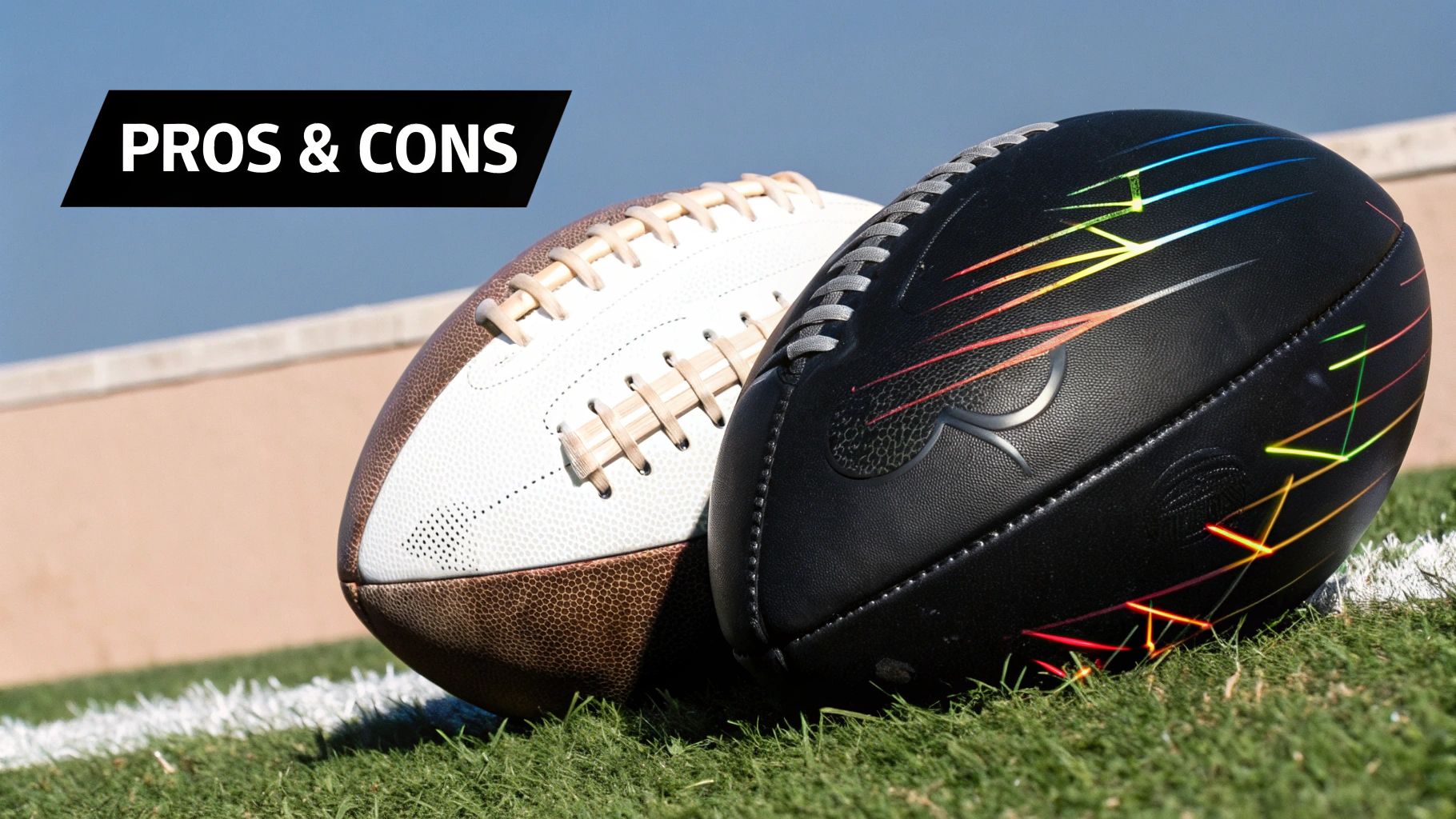If you're looking for that competitive edge, the right smart football can give you the data-driven feedback that genuinely transforms your training. Right now, the Adidas miCoach and DribbleUp are leading the charge in the UK. miCoach focuses on deep technical analysis for set-pieces, while DribbleUp nails interactive, game-like skill-building. These aren't just footballs; they are intelligent training aids that provide real-time metrics on your kicks, helping you understand and refine your technique with every strike.
Understanding Smart Footballs and Their Technology

On the outside, a smart football looks and feels just like a traditional ball. Inside, however, it's a different story. The core is packed with sophisticated technology designed to capture and analyse your every move. It's not a gimmick; it's like having a personal performance lab tucked inside a size 5 ball.
At the heart of it all are tiny, integrated sensors. These typically include an accelerometer to measure changes in speed and a gyroscope to track rotation and spin. When you kick the ball, these sensors work together to record a huge amount of data in milliseconds.
All that information is then sent via Bluetooth straight to a companion app on your phone or tablet. Instantly, you get a detailed breakdown of your kick, turning that gut feeling of a 'good strike' into concrete, actionable data.
What Metrics Do Smart Footballs Track?
The data you receive offers insights that, until recently, were only available to professional athletes with access to expensive equipment. While a smart football will never replace a coach, it acts as an invaluable assistant, giving you instant feedback when you need it most.
Here are the key metrics you can expect to see:
- Kick Speed: This measures how fast the ball is travelling, giving you a clear indicator of your shot power.
- Spin Rate: It tracks the ball's revolutions per minute (RPM), which is crucial for mastering curve, dip, or even tricky knuckleball techniques.
- Strike Point: The app shows you exactly where your foot made contact, helping you to achieve consistent and clean strikes.
- Flight Path: This visualises the ball's trajectory, allowing you to fine-tune your launch angle for everything from free-kicks to long cross-field passes.
Smart footballs make performance data accessible. They allow dedicated players at any level to analyse their technique with a level of detail that was once reserved for the elite. It’s all about putting professional-grade feedback in everyone’s hands.
This technology is a significant development in the UK sports equipment market, where there's a growing appetite for data-enhanced training. Globally, the football market was valued at nearly USD 885.9 million in 2025, and Europe, including the UK, makes up over 30% of that figure. It's clear that technology is shaping how we train.
By translating raw sensor data into easy-to-understand visuals and fun challenges, these apps make training far more engaging. It's part of a wider trend in sports tech, similar to how players use other tools to get an edge. To see what I mean, check out our PlayerMaker Smart GPS Soccer Tracker review.
Ultimately, a smart football provides the objective feedback needed to turn repetitive practice into genuine, measurable progress on the pitch.
What to Look For When Comparing Smart Footballs

Before you spend your money, it’s crucial to know what separates a top-tier smart football from a glorified gadget. They aren’t all made equal, and their real worth is hidden in the details. To give you a proper review, we need to focus on what actually helps you improve on the pitch.
The single most important factor is the quality of the data it produces. This isn't just about raw numbers; it’s about getting feedback that you can actually use. A brilliant smart football gives you specific, targeted advice to tweak your technique.
Core Performance Metrics
The real magic of a smart football lies in its ability to track the physics of your kick. These are the non-negotiable data points that provide the feedback you need to train effectively.
- Kick Velocity: This is a straightforward measure of your power. Tracking it consistently helps you see real gains as you work on your striking technique and build leg strength.
- Spin Rate: Measured in revolutions per minute (RPM), this is vital when it comes to mastering control. A high spin rate helps you bend it around a wall, while understanding backspin is key for that perfect dipping shot.
- Launch Angle: This shows the ball's initial flight path. Analysing it helps you perfect the loft for a pinpoint cross, a long diagonal pass, or keeping a thunderous shot under the crossbar.
- Strike Accuracy: Nailing where your foot connects with the ball is essential. The app should give you a clear picture of your strike point, helping you develop cleaner, more consistent contact every time.
The real value isn't just seeing the numbers; it's understanding how they connect. For instance, seeing how a tiny change in your strike point affects your spin rate is the kind of insight that leads to breakthrough moments in training.
Practicality and User Experience
Putting the raw data aside for a moment, the practical side of a smart football determines whether it becomes a training essential or just gathers dust. These factors are just as important as the sensors inside.
First up, battery performance is a huge consideration. A ball that’s always dead is useless. We look not just at how long a charge lasts, but also how easy it is to power it up—is it a simple wireless pad or a fiddly physical port?
Next is the companion app. It absolutely has to be easy to use, stable, and work properly on both iOS and Android. A clunky app can ruin the whole experience, no matter how good the ball is. We also test the Bluetooth connectivity, because an unreliable connection makes the whole thing pointless.
Finally, we have to talk about the ball's feel and durability. A smart football should feel as close to a proper match ball as possible. We check its construction, weight, and how it holds up on different surfaces, from a perfect grass pitch to unforgiving astro-turf, to make sure it can handle proper, tough training sessions.
Head-To-Head Smart Football Comparison
When you line up the top smart footballs side-by-side, two distinct philosophies emerge. Some models aim to deliver granular data so you can fine-tune every curve and spin. Others turn drills into a game, prioritising engagement over endless statistics.
In this guide, we’re focusing on the smart balls most readily available to UK players. We’ll measure them against four critical criteria: data accuracy, battery life, app usability, and the all-important ball feel on the pitch.
Before diving into the finer details, here’s a quick breakdown of key specifications and performance tracking capabilities.
Smart Football Feature And Performance Comparison
| Feature | Adidas miCoach Smart Ball | Wilson X Connected Soccer Ball | DribbleUp Smart Soccer Ball |
|---|---|---|---|
| Data Accuracy | High – measures spin, trajectory and power | Medium – tracks kick speed and distance | Moderate – uses phone camera for position |
| Battery Life | Up to 4 Hours | Up to 5 Hours | Continuous (phone-powered) |
| App Usability | Technical dashboards and trend graphs | Balanced mix of stats and guided drills | Interactive drills with visual prompts |
| Ball Feel | Thermally bonded panels for match-like touch | Traditional mould-built feel | Durable build, slightly heavier |
| Ideal Use Case | Set-piece specialists and coaches | All-round practice and skill tracking | Young players building footwork fundamentals |
As the table shows, you’re often trading raw accuracy for longer battery life or a more playful experience. Your choice depends on whether you want a hard-data tool or a skill-building companion.

Data Accuracy And Feedback Loop
First up: how precise is the feedback? The Adidas miCoach Smart Ball shines here, with sensors tuned to detect even subtle shifts in spin rate and trajectory. It’s perfect if your focus is on mastering free-kicks or corner deliveries.
On the other hand, Wilson’s offering strikes a middle ground—solid speed and distance metrics without overwhelming you with numbers. Then there’s DribbleUp, which relies on your phone’s camera to track movement. It won’t give you power readings, but for footwork and close-control drills, it’s surprisingly effective.
While the Adidas miCoach provides granular data ideal for set-piece specialists, the DribbleUp’s interactive drills offer a more engaging experience for younger players building foundational skills.
User Experience From App To Pitch
Beyond the numbers, day-to-day usability makes or breaks a smart ball. Setup is generally a simple Bluetooth pairing process, but the apps vary wildly in design.
- App Navigation: DribbleUp wins points for an intuitive, game-like interface that guides you through each drill.
- Data Presentation: The miCoach app takes a more clinical approach, laying out graphs and trend lines for serious analysis.
- Connectivity: All three models held a stable Bluetooth link in our tests, though a momentary drop can mean a missed kick registration.
A smart football must also feel like a real match ball. The miCoach uses thermally bonded panels that mirror a high-end Adidas match ball. Wilson opts for a classic feel that most players will be familiar with. DribbleUp’s ball is built tougher, slightly heavier, and geared towards stationary skill sessions. For more training accessories, check out the football essentials at SoccerWares.com.
Ultimately, the best smart football aligns with your goals. If dead-ball precision is your priority, you’ll appreciate the miCoach’s detailed analytics. If you want skill-building that feels like play, DribbleUp is the more suitable partner.
So, Is a Smart Football Actually Right for You?

Let's be honest, a smart football is a serious piece of kit and a proper investment. It’s definitely not for everyone. Before you spend your money, it’s worth thinking hard about how you train and what your goals really are.
This kind of tech really comes alive during focused, repetitive practice. If you're the type of player who spends hours mastering free-kicks or perfecting your crossing, a smart ball gives you incredible, instant feedback on things like spin and trajectory. It can genuinely speed up your learning. But for a casual kickabout in the park? It's probably overkill.
The interest in these gadgets is part of a much bigger picture. The UK football market, which includes all this new technology, reached around USD 422.23 million in 2024. It’s only set to grow, which shows just how much players and coaches are buying into tech-driven training. You can read the full research on the UK football market here if you fancy a deeper dive.
Who Actually Gets the Most Out of a Smart Football?
To help you decide, let’s look at who really benefits. See if any of these profiles sound like you—it should make the decision a lot clearer.
- The Aspiring Academy Player: For any young player serious about making it, a smart ball is a fantastic training partner. It adds structure to their solo practice, giving them the data to see and understand tiny improvements in their striking technique.
- The Committed Amateur: If you play regularly and are obsessed with improving one specific thing—like knuckleball free-kicks or long-range passing—the detailed feedback is a game-changer. It turns a hit-and-hope session into proper, measurable training.
- The Data-Driven Coach: Coaches can use a smart ball to add a layer of hard facts to their feedback. Instead of just saying, "you need more curve," they can show a player the exact spin rate and track their progress week by week.
- The Supportive Parent: If you have a child who lives and breathes football, a smart ball can be a brilliant investment. It makes practising at home more engaging and turns skill development into a game, keeping them motivated.
It all boils down to one thing: commitment. A smart football offers the most value to players who will actually use its feedback to analyse and tweak their technique. For the dedicated, it’s a powerful tool; for the casual player, its best features will probably go unused.
Weighing Up the Cost vs. Your Goals
Ultimately, it’s your call. Are you just after a new ball for a weekend five-a-side match, or are you looking for a specialist tool to take your game to the next level? It's no different from other pieces of performance tech—you only get out what you put in.
Smart footballs are just one piece of the player analysis puzzle. If you’re also interested in tracking your movement and physical output on the pitch, it's worth learning about the benefits of soccer GPS tracking to see how different bits of tech can work together.
By matching the right gear to your specific goals, you ensure that every pound you spend is helping you get better on the pitch.
Our Final Verdict and Top Recommendations
After putting these smart footballs through their paces, it's clear there isn’t one single ‘best’ ball for every player in the UK. The right choice really comes down to what you want to achieve. Are you chasing hard data to refine your technique, or do you need something more interactive to make drills fun?
Instead of crowning an overall winner, we’ve broken down our top picks based on how you’ll actually be using them. This way, you can invest in a tool that is genuinely going to help you on the pitch.
Top Choice for Technical Analysis
For the player who is obsessed with the finer details, the Adidas miCoach Smart Ball is still the one to beat. Its greatest strength is the sheer depth and accuracy of its data, especially for set-pieces.
If your training sessions are all about perfecting the spin on a free-kick or mastering the trajectory of a corner, no other ball gives you that level of granular feedback. Think of it as a serious analytical tool, built for players who want to turn practice into a science.
Best for Skill Development and Fun
When it comes to getting younger players hooked or just making solo drills less of a chore, the DribbleUp Smart Soccer Ball is our hands-down favourite. It cleverly turns the grind of skill development into a game.
Using your phone’s camera and augmented reality, it offers live feedback and challenges that make mastering close control genuinely enjoyable. It’s a brilliant way to keep aspiring players motivated and practising those crucial fundamentals without it feeling like work.
The decision really boils down to your training philosophy. Go for the miCoach if you want detailed, clinical data to fine-tune specific skills. Opt for DribbleUp if you value engaging, game-like drills that build a solid all-round foundation.
Smart football technology has come a long way. It’s no longer just a novelty; it's a valuable training aid for dedicated players. While it will never replace a good coach, that instant feedback loop can seriously speed up your improvement.
For players curious about other on-field tracking technologies, our guide on PlayerMaker versus Catapult One offers more insight into the world of performance analytics. The future of training is already here, giving serious UK players the data they need to take their game to the next level.
Your Questions Answered: The Smart Football FAQ
Thinking about getting a smart football? It's normal to have a few questions before you commit. We get asked these all the time, so here are some straightforward answers to help you figure out if one of these is right for your training.
Just How Tough Are These Smart Footballs?
This is probably the biggest concern we hear. Are the electronics inside going to break after a few powerful shots? The short answer is no. Most smart footballs are built to a high standard, with thermally bonded panels you'd find on a premium match ball. They’re designed to be kicked, and kicked hard.
That said, you need to treat it with respect. Think of it as your best match ball, not a scuffed-up street ball. It'll handle grass and modern 3G/4G pitches just fine, but keep it away from abrasive surfaces like concrete or gravel. These will damage the outer casing and could eventually harm the delicate sensors inside.
Do I Need to Pay for a Subscription to Use the App?
Thankfully, this is one area where manufacturers have got it right. For the big names like the Adidas miCoach and DribbleUp, the main features of the companion app come included with the purchase. You buy the ball, you get the app and all its core data tracking and training drills without any annoying monthly fees.
It’s always worth double-checking the small print before you buy, though. Some brands might offer optional premium features or advanced analytics as an in-app purchase down the line. However, for the core experience, the main models we've reviewed are ready to go straight out of the box.
The most important thing to remember is that smart footballs are specialist training tools, not official match balls. They're built for practice sessions, not for competitive, sanctioned games.
Can I Use a Smart Football in a Real Match?
That’s a definite no. Smart footballs aren’t certified by governing bodies like the FA for official matches. The internal sensors and battery add a small amount of weight and can slightly alter the ball's balance and flight compared to a standard, regulation ball.
It’s best to think of it like any other piece of training gear—such as a rebounder or a set of agility cones. Its job is to give you feedback and help you sharpen your skills during practice, so when you step onto the pitch for a real match with a standard ball, your technique is better than ever.
How Accurate is the Data, Really?
For what they’re designed to do, the accuracy is surprisingly good. They are excellent at tracking key metrics like kick speed, spin rate, and the exact strike point on the ball with a high degree of consistency. The feedback is more than reliable enough to help you make real, meaningful tweaks to your technique.
Let's be realistic, though. A smart ball isn’t going to give you the same level of 3D trajectory mapping you see on a Premier League broadcast—that requires a multi-camera stadium setup. But for personal training and seeing real improvement on the pitch, the data is absolutely spot on.
Ready to take your training to the next level? Explore the latest in football technology and fan gear at SoccerWares. Find everything you need to support your club and enhance your game at https://soccerwares.com.

